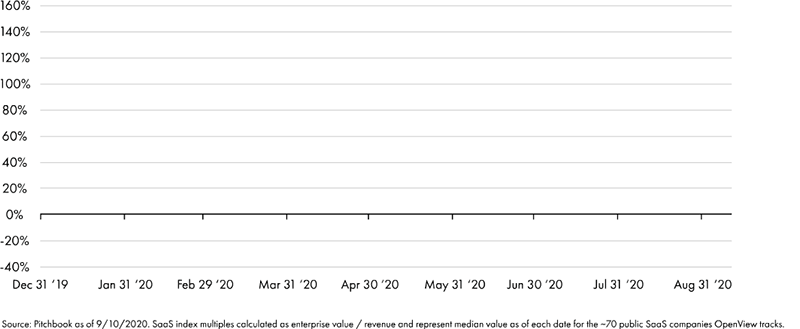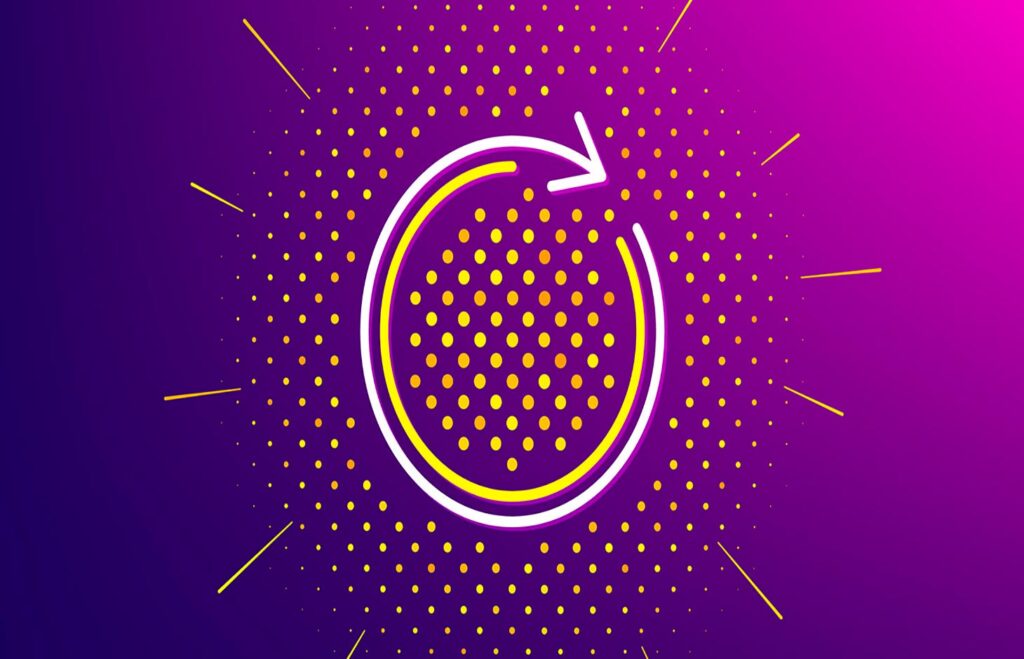There’s a long list of industries that took a hit this year. Airlines, restaurants, retail, hotels, live entertainment venues, and more are still working to weather the storm—if they’ve managed to stay afloat at all.
Absent from that list, however, is software as a service (SaaS). Check out this graph from OpenView:

Clearly, enterprise SaaS is managing to thrive overall. If your SaaS business isn’t quite on the same trajectory, don’t worry. SaaS businesses dependent on or adjacent to hard-hit industries certainly felt the stinging effects of a worldwide pandemic more than others. Many survived by repurposing their solutions and/or retargeting their audiences.
For example, as demand rose for touchless experiences and transactions, dining platform Presto quickly added a free, customer-facing Contactless Dining Kit to its product. The app allowed guests to order and pay at participating restaurants without touching menus or paper checks. This move retained and even increased Presto’s value for customers, strengthening relationships for the long haul of 2020.
Now, with the promise of vaccines and a more fixed “new normal” on the horizon, SaaS businesses that have survived need to start making plans to thrive in the years ahead.
Here’s how to crank things up from hanging-in-there to rapid MRR growth.
Revisit your go-to-market strategy
First and foremost, SaaS businesses need to get back to work on their go-to-market (GTM) strategy, insists OpenView:
“In our view, it’s time to ramp back up GTM investment. Companies are acquiring and retaining their customers as efficiently as ever. They’re just not spending nearly enough on acquisition to actually reach those customers who have demonstrated they still want to invest in digital transformation.”
There’s no question that the events of 2020 accelerated digital transformation across industries. That trend is far from slowing down.
To maximize your SaaS business MRR growth, it’s time to double down on attracting customers that want to be a part of the future by optimizing and digitizing their processes. At this stage, avoiding digital transformation means getting left behind.
How do you attract and retain these customers? One idea is: With product-led growth (PLG).
Focus on product-led growth for MRR growth
Leaders have debated the pros and cons of remote work all year, and in many organizations, the jury is still out.
While employees seem to appreciate the flexibility of a work-from-home option, they also report longing the comradery that comes with sharing office space with colleagues. And after prolonged social distancing, who can blame them?
One thing’s for sure: remote work led to a surge of success for SaaS companies leveraging PLG.
While the majority of SaaS business claim to be employing at least one PLG tactic, less than 30% say it’s actually fundamental to their business.
So why PLG?
Remote work requires employees to get resourceful while solving problems and staying productive outside of the office. As they discover SaaS solutions with low barriers to entry, such as free versions that solve their immediate need, they’re likely to recommend the best solutions to colleagues and supervisors. This eventually leads to organization-wide adoption, and inevitably an upgrade to a paid subscription account.
PLG is more than just a free trial though, as we explained in our post on product-led growth for SaaS a while back. Once customers are acquired, the growth strategy doesn’t end there.
Ensure your SaaS customer success
You can’t achieve rapid MRR growth without loyal customers. Acquisition is one thing, but retention is quite another. By spending time on your customer success strategy, you can lock in a revenue-generating fan base that serves as a foundation for blast-off.
Customer success is the new growth engine for SaaS companies, according to Pipedrive CTO Sergei Anikin.
“[T]he customer success team must invest in the customers, continue to check in with them and help them with their approach to delivering on their business goals,” he explains. “It’s a challenge to change the nature of the products and services delivered and take a much longer-term view, but the rewards are a much ‘stickier’ relationship and a revenue pipeline extending for multiples longer than a one-and-done approach.”
Ongoing customer success means looking beyond acquisition and onboarding and mapping a complete customer journey.
When customers implement your solution, how do you ensure they achieve their goals? If their needs change in the future, will your product or service be there to adapt with them?
Under the surface of customer success, there’s also another thing to consider: the product itself.
“Even if your customer seems to be happy,” Anikin warns, “there are always problems to solve. If you don’t find and solve them, your competitor will.”
This leaves one final arena in the effort to secure rapid MRR growth.
Reassess your SaaS offering
Presto’s Contactless Dining Kit ensured the business’s longevity in a time of great change, but it doesn’t have to take a pandemic to drive innovation. Nor does innovation have to stop when the dust appears to be settling.
Times like this are the perfect moment to reassess your offerings and consider where—or whether—they fit in the months and years ahead.
Have certain services or features fallen out of favor in recent months? If so, do you see them making a comeback? What kind of customer feedback are you getting about the limitations of your offerings?
Another great source of input is your development team. What software problems are your team aware of that are holding processes back? What do they need to solve them?
Slava Vanikov, CEO and Co-founder of software development agency Softermii, says while it can be tough to motivate dev teams to proactively look for and address areas of improvement, it isn’t impossible. Investing in new technologies and training, offering incentives for meeting certain KPIs and goals, and supporting participation in initiatives like hackathons can inspire team members to look at old code in a new light.
With fresh perspectives, support from leadership, and clear rewards or recognition for good work, your offerings will continually evolve and improve.
Preparing to (re)launch business and MRR
As SaaS businesses emerge intact from the challenges of the pandemic, they’re well-positioned to rocket into a future of rapid MRR growth. Agility, thanks to tech-enabled remote teams and some of the most innovative minds in business today mean those that survived can thrive.
Most businesses anticipate an increased post-pandemic demand across almost all SaaS verticals and they’re ramping up to meet this demand with investments in GTM teams and strategies.
The right PLG-informed GTM strategy, customer success management, and motivated dev team, are some additionally ways in which SaaS businesses can make the most of their investment and the exciting future ahead.








